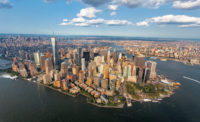This month marks the opening of the first Chicago Architecture Biennial, which is also the first such event in North America (October 3'January 3). The setting couldn't be more appropriate: in the realm of modern architecture, Chicago has never been the second city. Yet the Biennial, as its cocurators, Sarah Herda and Joseph Grima, point out, isn't just celebrating local architecture and history; instead, it is turning a wide lens on the future of design around the world. With more than 100 mostly young, international firms showing their work, and dozens of programs, installations, and pop-up projects in a variety of neighborhoods, the city will be both backdrop and foreground to this major three-month-long happening.
So it seems a good moment to take Chicago’s pulse once more as a capital of architecture and urbanism, and in the pages ahead, Architecutural Record explores the city’s past, present, and future. It was the birthplace of the skyscraper—or was it? That depends more on technical innovation than just height. It was, of course, the city where Mies van der Rohe landed in the U.S. and refined his vastly influential brand of postwar modernism. In an essay, “The Place Between,” writer Thomas Dyja extols Mies’s 1956 masterpiece, Crown Hall at IIT, while eulogizing the immense 1892 apartment complex, home to generations of African-Americans, that was razed to clear the site. As Dyja demonstrated in his award-winning book, The Third Coast: When Chicago Built the American Dream, the city was a crossroads of migrants, cultures, and aspirations, with a history of racial, social, and economic dissonance still much in evidence. Long after the demolition of the city’s infamous housing projects such as Cabrini-Green, for example, the provision of decent dwellings for a diverse, low-income population remains a serious problem.
But Chicago knows how to put on a beautiful face—thanks in good part to the 1909 Burnham Plan, with its abundance of public spaces, on the shores of Lake Michigan and dotting the neighborhoods. Now even the once-industrial Chicago River, cutting through downtown, boasts the elegant Riverwalk. The greatest ode to the idea of the urban park may be Seurat’s painting A Sunday on La Grande Jatte, which hangs serenely in the Art Institute of Chicago—and just beyond the museum’s doors is the best contemporary urban space in America, Millennium Park; its expansive new neighbor, Maggie Daley Park, stretches to the lakefront. RECORD contributing editor Blair Kamin, the Pulitzer Prize–winning critic of The Chicago Tribune, explores these public places, including the decidedly unglamorous 606 elevated trail, as significant works of contemporary design.
As a new generation of gifted Chicago architects, including Jeanne Gang and John Ronan, is building in the city and beyond, up-and-comers are finding a congenial environment for experimentation. We look at some emerging local designers, who were chosen to be in the Biennial and whose work lies as much in the realm of ideas as in bricks and mortar.
Conceptual thinking has never been a big part of Chicago’s architectural scene, notes Mr. Chicago himself, Stanley Tigerman, in a conversation with RECORD. Mies’s alleged admonition “build, don’t talk” fits perfectly with the city’s pragmatic, anti-intellectual stance as a hub of commerce. Now the Biennial is poised to be an enormous and provocative laboratory of both thinking and making.
When Nelson Algren wrote, “Chicago is an October sort of city even in spring,” he wasn’t talking about the seasons. The year was 1951, and the renowned chronicler of the down-and-out saw decline in the city’s pervasive grittiness and inequities. That was before Mies built Crown Hall, before Skidmore, Owings & Merrill built Inland Steel, before Bertrand Goldberg built Marina City—and well before Ronan built the Poetry Foundation. And while great architecture can’t solve all the city’s problems, it can help create a place of promise. This month, Chicago is an October city of a very vibrant sort.





Post a comment to this article
Report Abusive Comment